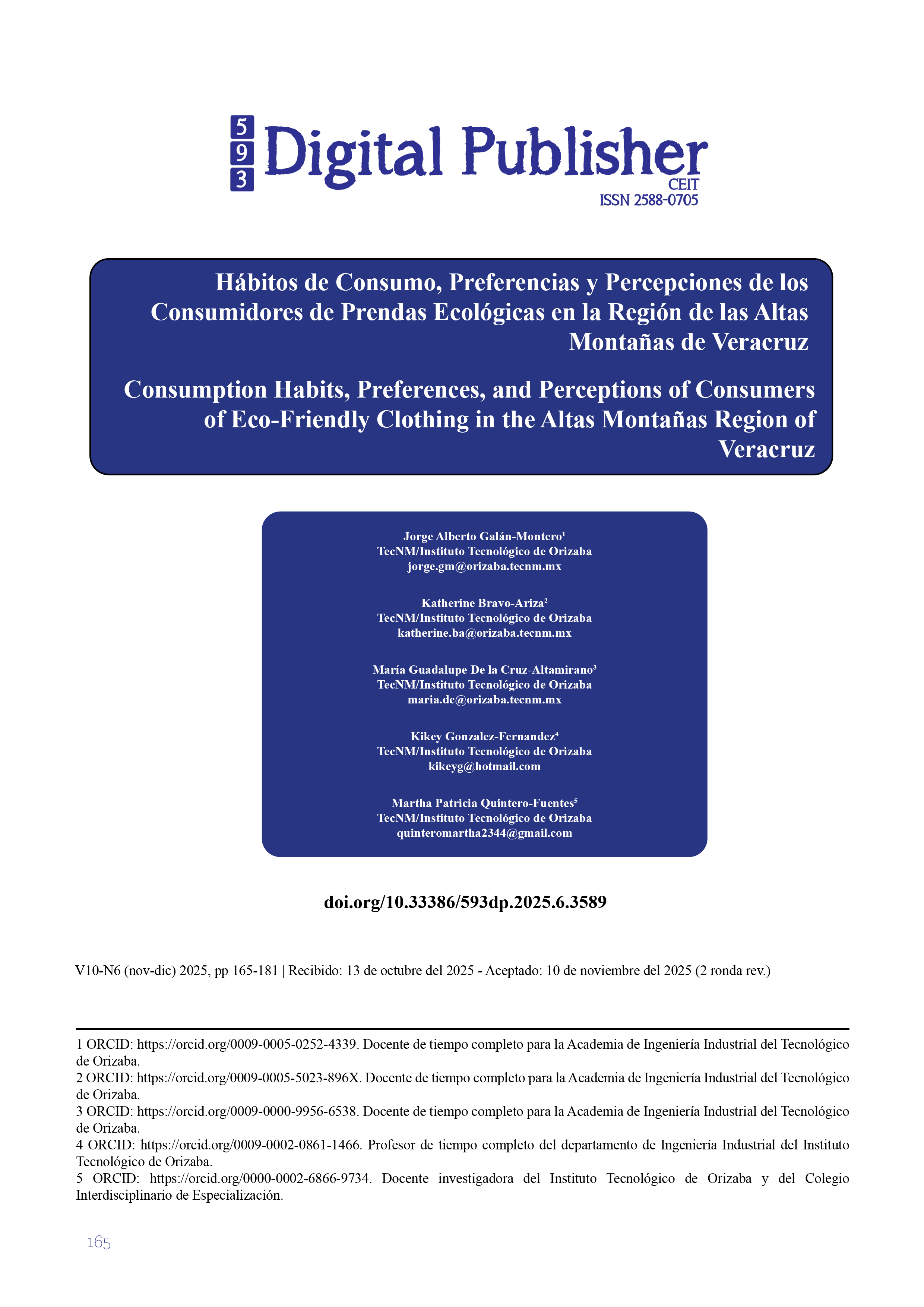Consumption Habits, Preferences, and Perceptions of Consumers of Eco-Friendly Clothing in the Altas Montañas Region of Veracruz
Main Article Content
Abstract
Analysis of the eco-friendly clothing market can offer opportunities to link artisanal production with sustainable innovation. To do so, it is necessary to identify the factors that influence purchasing decisions. The objective of this research was to analyze the eco-friendly clothing market and consumer behavior in the high mountain region. Quantitative, non-experimental, cross-sectional, descriptive research. Non-probability convenience sample of potential consumers between the ages of 25 and 70 residing in the high mountains. The instrument was designed with 24 items comprising general data and five dimensions (consumption habits and preferences, supply and demand, sales price, commercial strategies (social networks), and distribution channels). The instrument was validated by expert judgment with CVI indices greater than 0.83. Results and conclusions: The market for eco-friendly clothing has significant potential in the high mountain region of Veracruz. The sustainable consumer profile is characterized by women with higher education, middle incomes, and a preference for products that balance sustainability and design. However, the willingness to pay higher prices remains limited. Social media, especially Facebook and Instagram, are the most influential channels for promoting eco-friendly fashion.
Downloads
Article Details

This work is licensed under a Creative Commons Attribution-NonCommercial-ShareAlike 4.0 International License.
1. Derechos de autor
Las obras que se publican en 593 Digital Publisher CEIT están sujetas a los siguientes términos:
1.1. 593 Digital Publisher CEIT, conserva los derechos patrimoniales (copyright) de las obras publicadas, favorece y permite la reutilización de las mismas bajo la licencia Licencia Creative Commons 4.0 de Reconocimiento-NoComercial-CompartirIgual 4.0, por lo cual se pueden copiar, usar, difundir, transmitir y exponer públicamente, siempre que:
1.1.a. Se cite la autoría y fuente original de su publicación (revista, editorial, URL).
1.1.b. No se usen para fines comerciales u onerosos.
1.1.c. Se mencione la existencia y especificaciones de esta licencia de uso.
References
Araque Geney, E. A., & Álvarez Contreras, D. E. (2023). Gestión estratégica de los emprendimientos femeninos del sector artesanal, priorizado en la ruta competitiva del departamento de Sucre. Revista CEA, 9(21), e2467. https://doi.org/10.22430/24223182.2467
Araque Geney, E. A. (2021). Marketing digital como estrategia de posicionamiento para el comercio artesanal. Negonotas Docentes, (17), 37–46.
Arellano Grajales, B., & Bocanegra Gastélum, C. (2021). E-pymes de exportación textil artesanal mexicana, en tiempos de integración virtual y economías digitales. Indiciales, 1(1), 78–87. https://doi.org/10.52143/2346-1357.764
Ayala-Arroyo, K. L., Rivas-Tovar, L. A., & Cárdenas-Tapia, M. (2023). Redes empresariales y patrones de cooperación en mipymes textiles en México. Revista Universidad & Empresa, 25(44), 1–28. https://www.redalyc.org/journal/1872/187277413004/html/
Balasubramanian, M., & Sheykhmaleki, P. (2024). Comprehending the consumer behavior toward sustainable apparel. Sustainability, 16(18), 8026. https://doi.org/10.3390/su16188026
Biswas, A., & Roy, M. (2015). Green products: An exploratory study on the consumer behaviour in emerging economies of the East. Journal of Cleaner Production, 87(1), 463–468. https://doi.org/10.1016/j.jclepro.2014.09.075
Bumin, Z., & Bumin, M. (2024). Analysis of consumer preferences in sustainable fashion consumption. Journal of Innovations and Sustainability, 8(3), 01. https://doi.org/10.51599/is.2024.08.03.01
Calle Muñoz, L. M., & Ordoñez Gavilanes, M. E. (2024). Modelo de negocios para impulsar la comercialización en emprendimientos artesanales. Revista Científica Sapientiae, 7(13), 30–39. https://doi.org/10.56124/sapientiae.v7i13.0003
Creswell, J. W., & Creswell, J. D. (2018). Research design: Qualitative, quantitative, and mixed methods approaches (5th ed.). SAGE Publications.
Gwilt, A. (2020). Fashion design for living: Sustainable approaches to fashion. Routledge.
González Meneses, J. H., Arroyo Ávila, J. R., & Alvídrez Díaz, M. R. F. (2023). La importancia económica de las MiPyMES en México. Excelencia Administrativa Online, 4, 82–91. Facultad de Contaduría y Administración, U.A.CH.
Han, T. I., Seo, Y., & Ko, E. (2017). Staging luxury experiences for understanding sustainable fashion consumption: A balance theory application. Journal of Business Research, 74, 162–167. https://doi.org/10.1016/j.jbusres.2016.10.029
Haws, K. L., Winterich, K. P., & Naylor, R. W. (2014). Seeing the world through GREEN-tinted glasses: Green consumption values and responses to environmentally friendly products. Journal of Consumer Psychology, 24(3), 336–354. https://doi.org/10.1016/j.jcps.2013.11.002
Joergens, C. (2006). Ethical fashion: Myth or future trend? Journal of Fashion Marketing and Management, 10(3), 360–371. https://doi.org/10.1108/13612020610679321
Joshi, Y., & Rahman, Z. (2015). Factors affecting green purchase behaviour and future research directions. International Strategic Management Review, 3(1–2), 128–143. https://doi.org/10.1016/j.ism.2015.04.001
Joy, A., & Peña, C. (2017). Sustainability and the fashion industry: Conceptualizing nature and traceability. Fashion Theory, 21(5), 573–593. https://doi.org/10.1080/1362704X.2016.1241130
Kim, H., & Hall, M. (2015). Green brand strategies in the fashion industry: Leveraging connections of the green economy. Fashion Practice, 7(1), 87–102. https://doi.org/10.2752/175693815X14182200335531
Kumar, P., & Ghodeswar, B. M. (2015). Factors affecting consumers’ green product purchase decisions. Marketing Intelligence & Planning, 33(3), 330–347. https://doi.org/10.1108/MIP-03-2014-0068
Llanos Encalada, M., & Salazar Cueva, A. D. (2023). Efectos post pandemia en el desempeño del sector industrial textil ecuatoriano de ropa liviana: periodo 2020-2021. ECA Sinergia, 14(3), 129-141. https://doi.org/10.33936/ecasinergia.v14i3.5665
Lynn, M. R. (1986). Determination and Quantification Of Content Validity. Nursing Research, 35(6), 382-386. https://doi.org/10.1097/00006199-198611000-00017
Muñoz-Valera, S. (2020). La ecologización de la industria de la moda: actores y procesos. Anduli: Revista Andaluza de Ciencias Sociales, 19, 199–223. https://doi.org/10.12795/anduli.2020.i19.09
Niinimäki, K., & Hassi, L. (2011). Emerging design strategies in sustainable production and consumption of textiles and clothing. Journal of Cleaner Production, 19(16), 1876–1883. https://doi.org/10.1016/j.jclepro.2011.04.020
Organización de las Naciones Unidas. (2015). Objetivos de Desarrollo Sostenible. https://www.un.org/sustainabledevelopment/es/objetivos-de-desarrollo-sostenible
Patiño Delgado, A. L., Cervantes Escoto, F., Espinoza-Ortega, A., Palacios Rangel, M. I., & Cesín Vargas, A. (2022). Estrategias de microempresas dedicadas a la elaboración de queso artesanal en el trópico de México. Estudios Gerenciales, 38(164), 294–307. https://doi.org/10.18046/j.estger.2022.164.5038
Sandoval Trujillo, S. J., Ramírez Cortés, V., & Hernández Bonilla, B. E. (2023). Las Mipymes del sector turístico en Teotihuacán. TURPADE. Turismo, Patrimonio y Desarrollo, 2(18), 1–13. https://doi.org/10.21640/rt.v2i18.54
Serrano-Torres, M. G., & Quezada-Flores, M. L. (2025). La situación actual de las mipymes en México y el comercio informal post-covid-19. Ciencias Administrativas Teoría y Praxis, 21(1), 50–61. https://doi.org/10.46443/catyp.v21i1.466
Yusoff, M. S. B. (2019). ABC of Content Validation and Content Validity Index Calculation. Education In Medicine Journal, 11(2), 49-54. https://doi.org/10.21315/eimj2019.11.2.6
Instituto Nacional de Estadística y Geografía. (2023). A propósito del Día Internacional del Artesano (19 de marzo). INEGI. https://inegi.org.mx/contenidos/saladeprensa/aproposito/2023/EAP_ART23.pdf
Ludeña-Pérez, Á. F., Serdán-Valencia, K. N., & Romero-Hidalgo, O. M. (2022). Estudio de oferta y demanda para una asociación de producción textil y costura. Economía y Negocios, 13(1), 119–132. Universidad Tecnológica Equinoccial. https://doi.org/10.29019/eyn.v13i1.917
Calle Maldonado, J. A. (2023). Estudio de factibilidad para la creación de una empresa de confección de ropa deportiva en el cantón Latacunga. Universidad Técnica de Cotopaxi. https://dspace.ucacue.edu.ec/items/97132ddb-4fe1-4663-ab6d-396eaebde5ce






